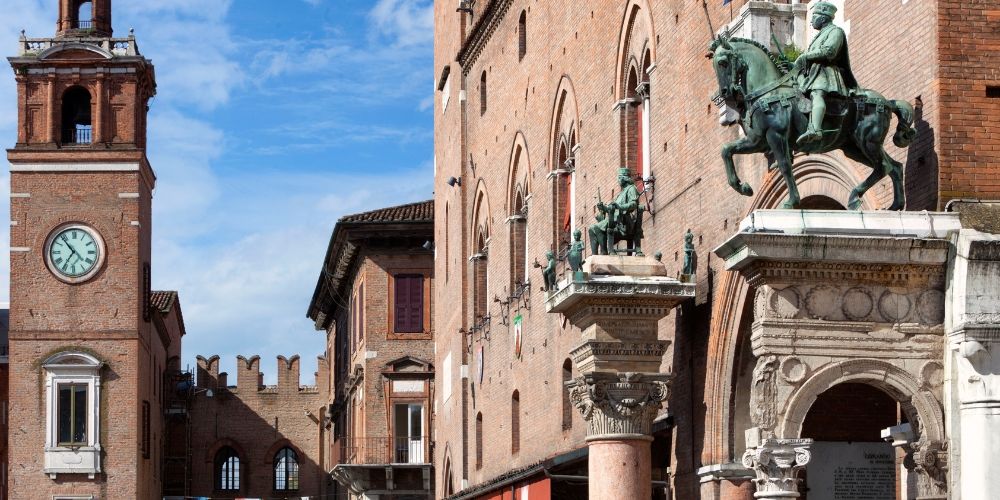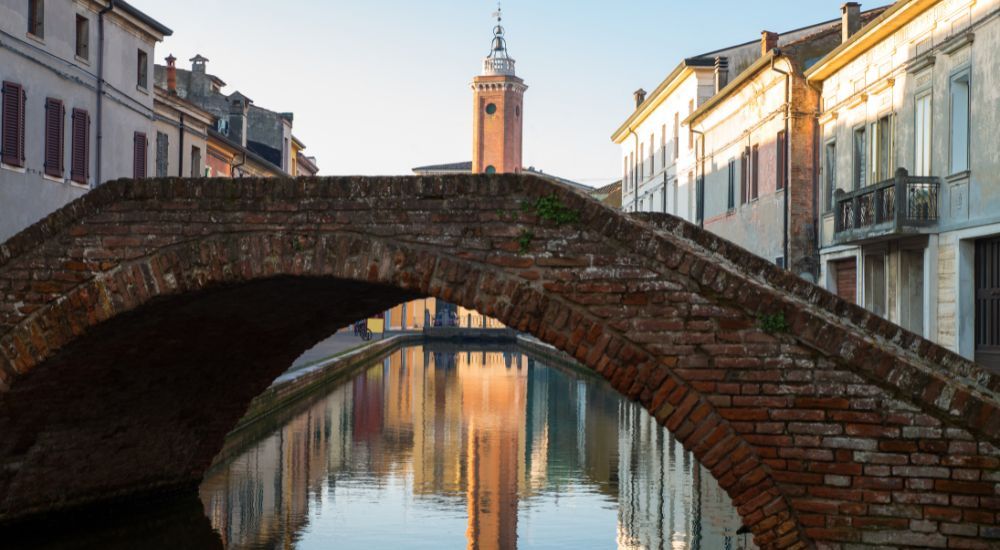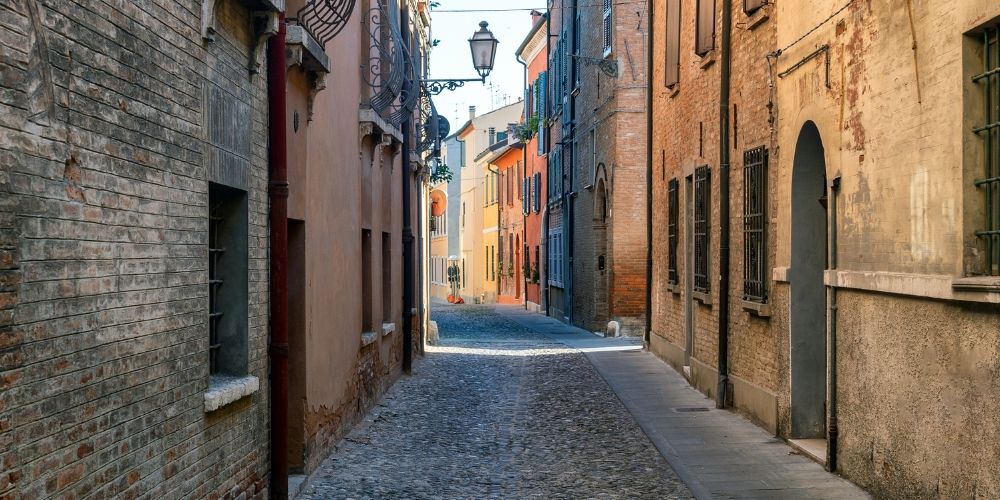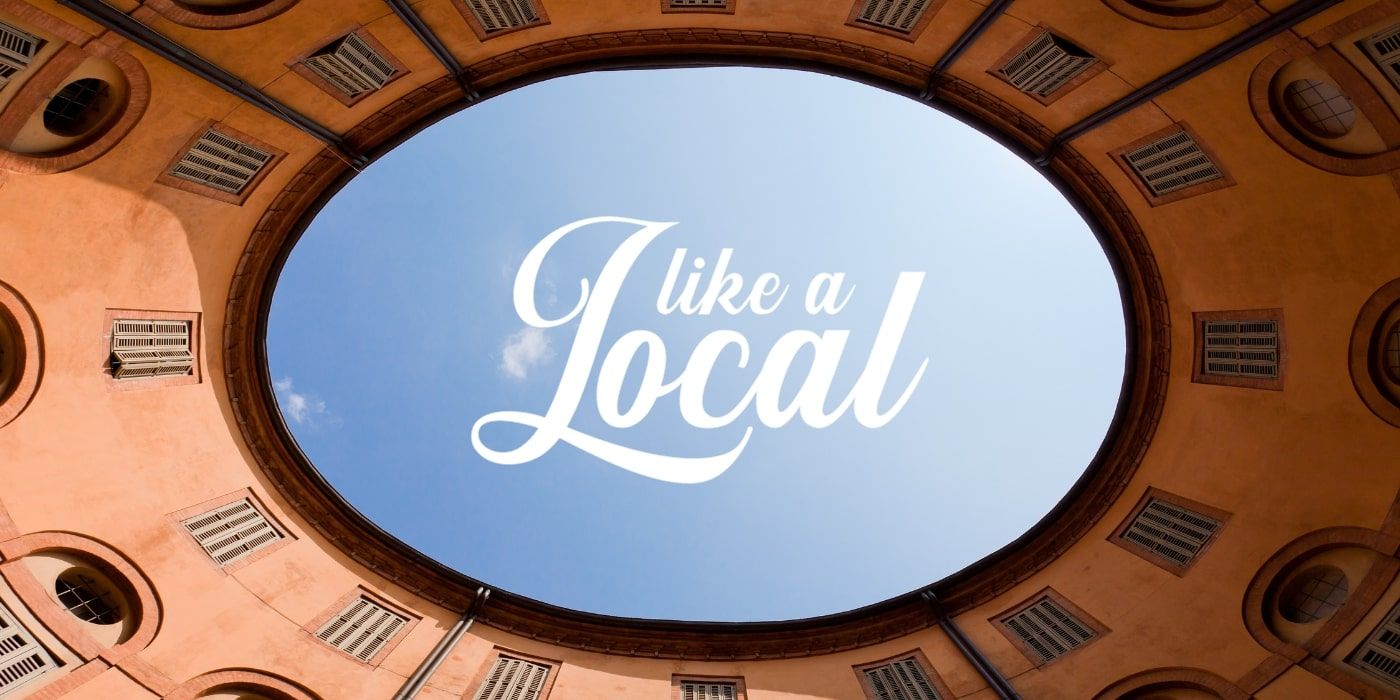Charming, welcoming and... tailor-made for cycling!
Ferrara is one of the most important cities of the Italian Renaissance and deserves to be fully explored, on foot or on two wheels.
The hand of the Estensi shaped to this medieval jewel: this powerful family made Ferrara an essential center for politics and culture in medieval Italy. Find out what to do and what to see to live it like a local.
What to do in Ferrara like a local

There is so much to see in the city, from the majestic Castello Estense and the Cathedral, to the marble-made Palazzo dei Diamanti. And also many scenic views across the narrow cobbled streets, the beautiful churches and the lively Piazza delle Erbe.
Ferrara is also full of young people attending the local university, giving the city a sparkling and avant-garde atmosphere, on top of the medieval layer offered by its ancient buildings.
Apart from the classic itineraries, follow our advice and discover the 10 things to do in Ferrara to enjoy the city like a local, from bike itineraries to unmissable events.
Also take a look at our article to learn more about Ferrara and its Unesco protected areas!
10. What to do in Ferrara like a local: rent a bike and explore the city centre
Ferrara is considered the most cyclist-friendly city in Italy.
If you stop in any corner of the city, you can see how Ferrara's cyclists are literally the owners of the road.
So to experience the city like a true local, rent a bicycle and ride in the city centre.
Lose yourself in the labyrinth of narrow streets and ancient buildings between the medieval center and the Jewish quarter.
There is certainly no shortage of shops offering two-wheel rental, from "Ricicletta" to "Pirani e Bagni" and "Scatto Felice": the price is around €10 per day. The cobblestones streets in the center can be a little unwelcome at first, but you get used to it quickly (and it makes the tour more charming).
There are several recommended itineraries for exploring Ferrara by bike.
To get the best of the Renaissance bit of the city, start by pedalling from the Castello d'Este towards the north-west along Corso Ercole d'Este up to the Palazzo dei Diamanti (maybe park your bike and visit the exhibitions of the Palazzo). Then take Corso Porta Mare up to the park of Piazza Ariostea, and from there continue towards the Church of San Cristoforo alla Certosa with its beautiful gardens. Finish the itinerary by reaching the House of Ludovico Ariosto, before returning to the starting point.
Equally interesting is the exploration of the Jewish quarter of Ferrara, one of the oldest Jewish communities in Italy - segregated here from 1624 until the unification of Italy. You can still appreciate the old palaces and shops of the ghetto and their almost intact structure. Via Mazzini was the heart of the ghetto, but the whole area is of great historical interest. To immerse yourself in the atmosphere of the neighbourhood, just read the beautiful novel "The Garden of the Finzi-Continis" by Giorgio Bassani (who also taught in a school in the ghetto).
Read our article on the best Italian cities to explore on a bike to know more.
9. Eat in a local restaurant like a local in Ferrara
Ferrara cuisine takes no prisoners.
One of the best ways to experience the city like a true Ferrarese is to book a table in a local restaurant and discover the flavours of the Emilia-Romagna countryside.
The local specialties range from cured meat to stuffed pasta and crunchy bread.
Start your meal with appetisers and savour the local varieties of seasoned cured meat (salame Zia Ferrarese, salama al sugo, mortadella) and cheeses, paired with the famous bread called “coppia ferrarese”. This crunchy X-shaped bread from Ferrara is so iconic that it was portrayed in a painting by Giorgio De Chirico called "The language of the child".
The most classic first course is the cappellacci alla zucca (aka "pumpkin cappellacci"): these delicious egg pasta tortelloni filled with pumpkin cream are the perfect synthesis between sweet and savoury, and received PGI recognition in 2016. Flavoured with parmesan cheese and nutmeg, pumpkin cappellacci are a must-eat if you are in Ferrara.
If you still have room, don't miss the typical pasticcio di maccheroni (aka "macaroni pie"), another first course combining sweet and savoury: a thin dome of puff pastry filled with macaroni with meat sauce, béchamel, parmesan, mushrooms and truffles. The perfect dish if you love strong flavours.
Wash down this feast of carbohydrates with local wines, often called "wines of the sands", as the vines grow in particularly sandy soils.
Close the sumptuous meal with a dessert: we especially recommend the torta tenerina ("soft cake", a dark chocolate delight with a crunchy crust hiding a creamy heart) and the panpepato (a dense ball with a spicy flavour made with almonds, walnuts, candied fruit and raisins and honey... a Christmas gem made throughout the winter).
Discover Bologna's tours8. Take a day trip to Little Venice and in a glorious art city

A scenic view of Comacchio.
The small town of Comacchio is also called 'Little Venice': a 10-minute walk in the city is enough for you to understand the reason for the nickname.
You can enjoy charming canals and bridges all over the spectacular city centre, built on a lagoon.
Half a day is enough to visit Comacchio, the classic day trip.
But there's more! You can stay all day in the area to pick your favourite out the seven city beaches: from Lido degli Estensi to Porto Garibaldi, you will certainly find your space on the beach for a relaxing day by the Adriatic Sea.
Among the activities to do in Comacchio we recommend a visit to the museum Delta Antico which tells the story of the river Po delta area, and a boat ride in the lagoon of the Valli di Comacchio, to discover the traditional eel fishing.
If you stop for lunch in the lagoon, book a table in one of the restaurants in the area, and enjoy an eel-based dish or one of the many other fish dishes. The wetland area of the Valli di Comacchio is protected by UNESCO and is really worth exploring.
Comacchio lies only 50 km from Ferrara: you can reach it by car (about 40 minutes journey) or with a combination of train and bus in about 80 minutes (regional train to Ostellato and then bus 331 to Comacchio).
Still in the mood to explore? Why not consider travelling from Comacchio to the stunning city of Ravenna and enjoy its beautiful art and UNESCO World Heritage attractions with the help of the Ravenna Pass. Our travel tips can help you make the most of this incredible experience.
Find more about Ravenna Pass7. Watch the Palio of Ferrara
The Palio of Ferrara is a historical re-enactment bringing celebration to the streets of Ferrara.
It is a competition between the eight districts of Ferrara: four wards inside the walls and four villages built outside participate in the event.
The districts compete in this palio which is considered the oldest in the world, originating from the celebrations for the victory obtained by Azzo VII d'Este in Cassano d'Adda in 1259, while he was at the head of the papal troops in the war against the imperial troops .
The Palio of Ferrara takes place on the last Sunday of May and offers exciting horse races, music games, flag-wavers and parades. The winning contrada of the adrenaline-pumping half-blood horse race wins the precious cloth of San Giorgio, patron saint of the city.
The weekends of the month of May are full of events attracting tourists and locals to the streets: in the city you can fill your lungs with the sparkling Renaissance atmosphere with various events, including a parade with thousands of figures from the Ducal Court walking around in medieval clothes.
Admission to the Palio is free but you have to show up well before the start of the games to secure your place. The different districts also offer seats in a paid stand (with prices around 50 euros).
6. Discover the festival Ferrara sotto le stelle
Combining international music stars, new emerging bands and lots of fun.
This is Ferrara sotto le Stelle (literally "Ferrara under the stars"): a music festival born in Ferrara in 1996 and which has entertained visitors and locals alike ever since under the banner of great music.
Ferrara sotto le stelle takes place in the evenings of June and July and offers live music, side events and catering, with also spaces dedicated to children (kids up to 10 years enter the concerts for free). In recent years the event has been held in Parco Massari and at the Nuova Darsena, a recently redeveloped open-air location connecting the people of Ferrara to their river.
Locals adore their festival and this event has seen top-notch musical bands and solo artists starting with Bob Dylan in 1996 and ending in recent years with Thom Yorke, Kasabian, Alt-J, Cosmo and Thegiornalisti. Most of musical genres are represented, so it's really hard to get bored!
To enjoy Ferrara like a local, visit the city during the days of the event and keep the evening free to appreciate the vibrant atmosphere before the concerts, chat with the locals and listen to great Italian and international artists live.
5. Visit Ferrara hidden gardens
There is a hidden and romantic Ferrara that lies behind the high walls of the historic palazzi in the city centre.
It is a unique heritage composed of medieval gardens and courtyards filled with flowers, centuries-old trees and perfectly designed hedges. Every September, you can discover this magical space by participating in a beautiful initiative called Interno Verde (Inside Green).
The event allows locals and tourists to explore some of Ferrara's most enchanting private gardens up close. Like Villa Hirsch, the residence that inspired Giorgio Bassani's The Garden of the Finzi-Continis.
However, there are many green spaces accessible to the public - Parco Massari in the city centre is the most significant public green space in Ferrara, and the 15th-century Giardino delle Duchesse is also a beautiful place to explore.
Additionally, the large Urban Park and the botanical garden are marvels where you can spend some peaceful moments among the many plant species and stroll in the company of some friendly ducks.
4. Meet a symbol of rationalist architecture
The 16th-century Palazzo Pio remains the only standing testament of Tresigallo's past. This town, located halfway between Ferrara and the Comacchio valleys, underwent a complete overhaul in the 1930s and was rebuilt according to rationalist taste by the best architects and engineers of that time.
You'll feel like in a De Chirico painting while visiting its perfect geometries of streets and buildings that have remained unchanged over the decades. Trapeziums, cones, cylinders, parallelepipeds, straight and square lines, harmonic symmetries, and chromaticism are all features that make this place unique. Its distinctiveness has earned it the appellation of Metaphysical City and recognition as a City of Art.
Tresigallo is a rare example of a town planned with the precise political and architectural intent of recreating a functional and orderly centre.
Explore this beautiful spot on your own with the help of the free audio-guide service available on the dedicated website or with a local guide.
3. Walk along the world's most beautiful road
Corso Ercole I d'Este is one of the pinnacles of Ferrarese urban design and, as accorded by UNESCO, one of the most impressive boulevards worldwide.
It gracefully links the Estense Castle to the Degli Angeli gate. At the intersection with the Corso Porta Mare-Corso Biagio Rossetti thoroughfare, it opens onto the Quadrivio degli Angeli, where the 'precious' façade of the iconic Palazzo dei Diamanti takes centre stage.
Expect not the presence of bustling bars and shops, for this is a long residential boulevard graced with elegant, age-old buildings, including the Naselli-Crispi, Giglioli-Varano, and Trotti Mosti palaces, Palazzo Gulinelli, Palazzo Giulio d'Este, and the neoclassical Palazzo Scola Camerini.
As you draw near the perimeter walls, you'll observe the stately architecture giving way to a distinctly rustic, almost bucolic ambience and scenery.
It's one of those spots that should be noticed, both for its atmosphere and historical significance. Traverse it to enter the irresistible age of Ferrara's Renaissance.
2. Discover a very special church...

Discovering rare gems and extravagant curiosities has always been a highlight of our trips. As for Ferrara, we stumbled upon the unconventional story of one of the last adult cinemas in Italy, the Mignon, which closed its doors in 2021.
However, what piqued our interest was the building's location – a 10th-century Byzantine church, one of the oldest in Ferrara. It's a testament to the sacred and profane life of Ferrara's history.
Despite being deconsecrated during the Napoleonic period, the construction has had a colourful history, serving as a warehouse, discotheque, gymnasium, and movie theatre.
Nevertheless, it has always retained its unique charm, remaining a place of worship of its kind, a symbol of an era and a world that no longer exist.
From the central Via Porta San Pietro, number 20, you can still catch a glimpse of the building, although it is currently closed and not open to visitors.
1. Wander through contemporary Ferrara
With its medieval charm, the influence of the Este family during the Renaissance era, and a contemporary vibe that continues to evolve, Ferrara is a multifaced city.
To witness its most modern and colourful side, stroll through the streets decorated with dynamic street art operas.
You can find an up-to-date map of graffiti and murals on the Ferrara Street Art website and create your ideal itinerary.
If you are an admirer of contemporary art, then a visit to Palazzo Massari on Corso Porta Mare is a must. This elegant 16th-century building has been home to the GAMC - Gallerie d'Arte Moderna e Contemporanea (Modern and Contemporary Art Galleries) since 1975. It houses a rich collection of works that trace the cultural and artistic history of Ferrara, making it a perfect goal for art lovers.
About the author
Written on 31/10/2023




Fabrizio Mariani
Do you want to visit Ferrara like a local? Then check out 10 things to get the best out of the city.